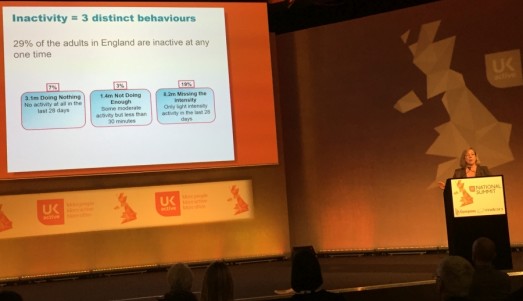Physical activity sector: England needs your help
11/11/2016

ISCA partner ukactive’s National Summit in London on 9 November sent a clear message to the physical activity sector: the nation’s public sport and health bodies need your help.
Sport England and NHS England’s (the national health service) leaders stressed the need to bridge the gap between research, policy, promotion and – ultimately – the impact they want to see among the public. And they realised that to meet this target they have to find a way to reach the grassroots.
Increasing physical activity levels in the UK is an agenda that gained momentum in connection with the government’s ambitions to fulfil legacy promises from the London Olympic Games. The government has indeed made big strides towards “tackling inactivity”, which is what Sport England aims to do with £250 million of funding over the next four years.
Who are the “inactive” and how do we reach them?
Ukactive's Chair, Baroness Tanni Grey-Thompson, wrote prior to the summit that inactivity is costing the UK up to £20 billion per year and is an underlying factor of 20 major physical conditions. At the summit she even described inactivity as “a source of national embarrassment” despite top-down efforts to reverse the trend.
But the “inactive” are a tricky bunch to grasp, Sport England’s CEO Jennie Price admitted. She divided the 29% of inactive English adults into three groups ranging from the completely sedentary to those who are not reaching the intensity of activity that can significantly benefit their health (see photo).
Efforts often focus on the crucial transition from inactive to some activity, but Price also mentioned those who stop doing regular vigorous physical activity as a particularly elusive group.
“If you ask most people, at some point they have has a serious engagement with physical activity but have stopped because of life circumstances… It’s so hard to grasp this section,” she said.
Sport England’s Director of Community Sport, Mike Diaper, used the renowned awareness campaign This Girl Can as an example of an effort that has succeeded in awareness-raising, but has encountered barriers with its target group being put off by lack of support when they try to put their inspiration into practice.
“I think we’ve got to be better at strengthening the part underneath,” he said, referring to developing the skills and behaviour of staff in health and physical activity centres, from doctors to receptionists who he describes as “the gateway to change”.
All guns blazing approach to finding customer-centric solutions
Sport England wants to reach a broad spectrum of inactive citizens at once, from youth to the elderly, girls and women, people with disabilities and ethnic minorities. But at the moment, Diaper says, the sport sector is still best at “catering for younger, fitter and more active people”.
From now to March the government body is unravelling a series of “customer-centric” initiatives and resources, including a Tackling Inactivity Insight Pack, 3-4 local delivery pilots (out of 10 proposed in total), the next phase of This Girl Can and a host of investments to all of the target groups it is trying to reach. With all guns blazing, it is in talks with organisations across sectors, from the physical activity sector to pension funds, to find its way to society’s elusive inactive members.
NHS England’s CEO Simon Stevens listed physical activity as second on its agenda, after food and beverages, as vital area for initiating change. He also listed a wide range of stakeholders the national health service wants to work, encouraging local authorities, for example, to “proactively seek out your hospital and ambulance service to find out how you can advance this [physical activity] agenda”.
Great ambitions = great opportunities
With Sport England “desperately” (according to Jennie Price) wanting to work with the physical activity sector and NHS England grappling for links with the same sector, which ukactive’s Tanni Grey-Thompson believes will help “save it from bankruptcy”, grassroots sport and physical activity organisations in the UK are in a prime position to pounce on new funding and opportunities being made available.
This urgency for cross-sector collaboration could also help create “a radical shift towards prevention over cure”, Grey-Thompson says, and she also sees it as an important opportunity for ukactive (and other active leisure organisations) to advocate for further state funding, including recommending “the [UK] government’s Industrial Strategy to lead a £1billion regeneration scheme to transform the UK’s ageing fleet of leisure centres into new community wellness hubs”.
Whichever way these ambitions and opportunities unfold over the following years, England will be a country to watch as it aims to leave its mark on its citizens and the physical activity space with the broadest brush it can find in its paintbox.
By Rachel Payne, ISCA
Posted on 11/11/2016 by Rachel Payne, ISCA

